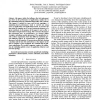Free Online Productivity Tools
i2Speak
i2Symbol
i2OCR
iTex2Img
iWeb2Print
iWeb2Shot
i2Type
iPdf2Split
iPdf2Merge
i2Bopomofo
i2Arabic
i2Style
i2Image
i2PDF
iLatex2Rtf
Sci2ools
93
Voted
PDP
2009
IEEE
2009
IEEE
Effects of Job and Task Placement on Parallel Scientific Applications Performance
—this paper studies the influence that task placement may have on the performance of applications, mainly due to the relationship between communication locality and overhead. This impact is studied for torus and fat-tree topologies. A simulation-based performance study is carried out, using traces of applications and application kernels, to measure the time taken to complete one or several concurrent instances of a given workload. As the purpose of the paper is not to offer a miraculous task placement strategy, but to measure the impact that placement have on performance, we selected simple strategies, including random placement. The quantitative results of these experiments show that different workloads present different degrees of responsiveness to placement. Furthermore, both the number of concurrent parallel jobs sharing a machine and the size of its network has a clear impact on the time to complete a given workload. We conclude that the efficient exploitation of a parallel comp...
Related Content
| Added | 19 May 2010 |
| Updated | 19 May 2010 |
| Type | Conference |
| Year | 2009 |
| Where | PDP |
| Authors | Javier Navaridas, Jose Antonio Pascual, José Miguel-Alonso |
Comments (0)

